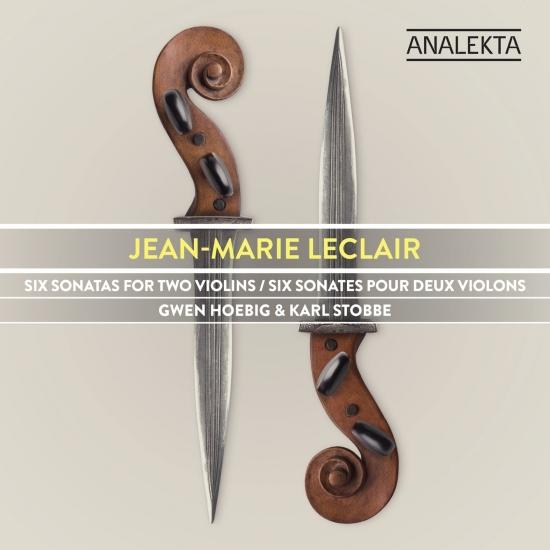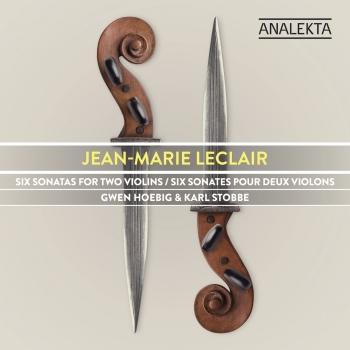
Jean-Marie Leclair: Six Sonatas for Two Violins Gwen Hoebig & Karl Stobbe
Album Info
Album Veröffentlichung:
2018
HRA-Veröffentlichung:
24.01.2019
Label: Groupe Analekta, Inc
Genre: Classical
Subgenre: Chamber Music
Interpret: Gwen Hoebig & Karl Stobbe
Komponist: Jean-Marie Leclair (1697-1764)
Das Album enthält Albumcover
- Jean-Marie Leclair (1697 - 1764): Sonata for Two Violins in G Major, Op. 3 No. 1:
- 1Sonata for Two Violins in G Major, Op. 3 No. 1: I. Allegro04:04
- 2Sonata for Two Violins in G Major, Op. 3 No. 1: II. Allegro ma poco03:02
- 3Sonata for Two Violins in G Major, Op. 3 No. 1: III. Allegro03:16
- Sonata for Two Violins in A Major, Op. 3 No. 2:
- 4Sonata for Two Violins in A Major, Op. 3 No. 2: I. Allegro03:30
- 5Sonata for Two Violins in A Major, Op. 3 No. 2: II. Sarabande - Largo02:35
- 6Sonata for Two Violins in A Major, Op. 3 No. 2: III. Allegro03:24
- Sonata for Two Violins in C Major, Op. 3 No. 3:
- 7Sonata for Two Violins in C Major, Op. 3 No. 3: I. Adagio – Vivace07:04
- 8Sonata for Two Violins in C Major, Op. 3 No. 3: II. Adagio02:57
- 9Sonata for Two Violins in C Major, Op. 3 No. 3: III. Allegro02:49
- Sonata for Two Violins in F Major, Op. 3 No. 4:
- 10Sonata for Two Violins in F Major, Op. 3 No. 4: I. Allegro assai03:08
- 11Sonata for Two Violins in F Major, Op. 3 No. 4: II. Aria - Andante grazioso03:59
- 12Sonata for Two Violins in F Major, Op. 3 No. 4: III. Gigue - Allegro moderato02:42
- Sonata for Two Violins in E Minor, Op. 3 No. 5:
- 13Sonata for Two Violins in E Minor, Op. 3 No. 5: I. Allegro ma poco04:37
- 14Sonata for Two Violins in E Minor, Op. 3 No. 5: II. Gavotte - Andante grazioso03:00
- 15Sonata for Two Violins in E Minor, Op. 3 No. 5: III. Presto03:18
- Sonata for Two Violins in D Major, Op. 3 No. 6:
- 16Sonata for Two Violins in D Major, Op. 3 No. 6: I. Andante02:01
- 17Sonata for Two Violins in D Major, Op. 3 No. 6: II. Allegro03:50
- 18Sonata for Two Violins in D Major, Op. 3 No. 6: III. Largo02:22
- 19Sonata for Two Violins in D Major, Op. 3 No. 6: IV. Allegro ma non troppo04:44
Info zu Jean-Marie Leclair: Six Sonatas for Two Violins
Two prominent Winnipeg Symphony Orchestra musicians, concertmaster Gwen Hoebig, and associate concertmaster Karl Stobbe offer an album rich in emotion and virtuosity. Opus 3 sonatas for two violins, by French composer Jean-Marie Leclair is an amazing work with lilting pastorals, graceful sarabandes and fiery jigs, is played admirably by Hoebig and Stobbe. Leclair, considered the father of violin in France, lived a tumultuous life that led to his assassination in 1764. His ex-wife and nephew, each with their own motives that could make them credible suspects, did not confess and the murder was never resolved.
Jean-Marie Leclair was born in Lyon, France, in 1697. Music was clearly important in his family life, as four of his five siblings would become professional musicians. Known as Jean-Marie “the elder” to distinguish him from his younger brother of the same name, he is widely considered the father of French violin playing, where he brought the violin to the same prominence it enjoyed in Italy and other centres.
Leclair had a strong education in the arts, and beyond music, was also well-read and versed in literature and dance. His first wife was a dancer, and it was in dance that Leclair made his initial mark in 1722, when he was appointed principal dancer and ballet master of the Teatro Regio in Turin. Ironically, his time as a dancer in Italy was significantly important for his music career. He was immersed in the virtuosic playing and dazzling compositions of the Italian violin world, and its influence would contribute a great deal to Leclair’s ever-growing powers, both as a performer and composer.
After several years of commuting between Turin and France, Leclair’s dance career gave way to music, and he returned to Paris, from where he would base a music career that would take him throughout Europe. Armed with the technical prowess of the great Italian violin school, he quickly showed the French public that the violin was more than just an orchestral instrument.
By staying true to the French dance forms and gentle lilting rhythms, he defined a style of French virtuosity that was never showy but held reserve and elegance alongside technical mastery. His compositions have moments of wonderful genius, developing effortless dialogue between instruments – sometimes tender, yet other times combative.
His Opus 3 sonatas for two violins envelop all those attributes, with lilting pastorals, graceful sarabandes, and fiery jigs. His melodic writing is
delicate and clean, yet the harmonic structures underneath can sometimes be thick and dense, almost organ-like. These are technically demanding works, requiring precision and delicacy, but always in the service of great music. Leclair’s genius shines in his ability to create colours and characters that continuously evolve.
The two violins constantly play off each other, in turn furthering a tender moment, sharing humour, or engaging in debate. The first and second violin parts are always of equal importance, continuously interjecting and mimicking each other – but not to sound identical, for each voice has its own character and contribution to make. Using the metaphor of temperamental lovers, one movement can be the height of romance, whereas the next is argumentative and bickering. In this thought there is a connection to Leclair in life. After the passing of his first wife, Leclair married his engraver, Louise Roussel, who took to engraving and publishing all of Leclair’s compositions. The relationship would not last, and the two would eventually divorce. The divorce left Roussel broke and dependent on others’ goodwill, and caused Leclair to move into a small house in a less than savoury part of Paris.
No stranger to scandal, Leclair also had a difficult relationship with a nephew. Guillaume-Francois Vial was a violinist who had wanted Leclair’s help in promoting his career. Leclair refused, and Vial apparently never forgave him for it. This is the background for Leclair’s untimely death – he was found stabbed to death outside his home in 1764. It seems his estranged wife had the best motive for carrying out the attack, inheriting his house and other possessions, with which she could find a way back to financial security. Perhaps she hired the gardener, who found the body and whose testimony seemed consistently inconsistent. Or perhaps suspicion should be directed to the nephew, who had the anger and resentment to fuel such an attack. The case was never solved, but those three individuals have remained the major suspects since the murderous act.
Leclair’s music does in some way seem to be a metaphor for his life, and it gives us an entry point into hearing and playing these sonatas. The intimacy of two violins working together through tribulations and trials, romance, and violence seems to be a good starting point to explore the characters found in these works. Hopefully that is evident in our approach: to go beyond the technical challenges that they demand and convey a sense of who the man was and the relationships that he had.
Gwen Hoebig, violin
Karl Stobb, violin
Keine Biografie vorhanden.
Dieses Album enthält kein Booklet











